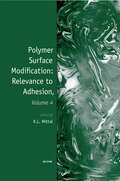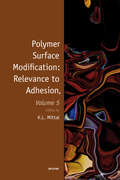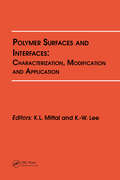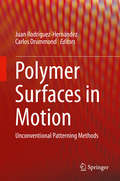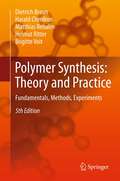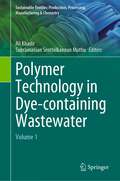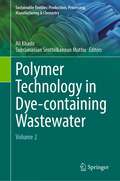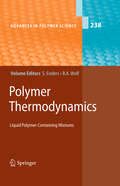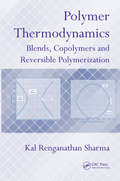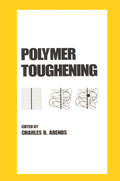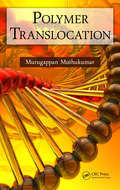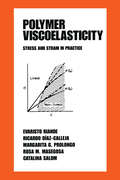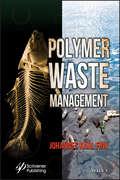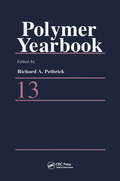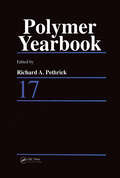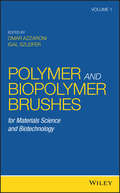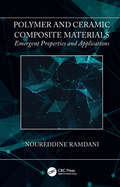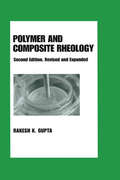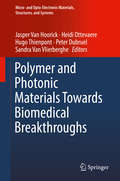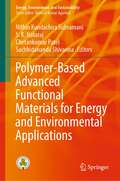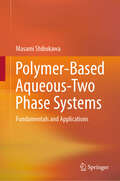- Table View
- List View
Polymer Surface Modification: Relevance to Adhesion, Volume 4
by Kash L. MittalThis book documents the proceedings of the Fifth International Symposium on this topic, held in Toronto. The book is divided into two parts: Part 1: Surface Modification Techniques; Part 2: Adhesion Improvement to Polymer Surfaces.Various ways to modify a host of polymer surfaces for a variety of purposes are covered in this book, with emphasis on
Polymer Surface Modification: Relevance to Adhesion, Volume 5
by Kash L. MittalThe topic of polymer surface modification is of tremendous contemporary interest because of its critical importance in many and varied technological applications where polymers are used. Currently there is brisk research activity in unraveling the mechanisms of surface modification and finding ways to prolong the life of surface treatment. Also the
Polymer Surfaces and Interfaces: Characterization, Modification and Application
by K. L. Mittal K. W. LeePolymeric materials are used for a legion of applications in a wide array of technological areas, and their proper surface/interface characteristics are of cardinal importance for their applications. Therefore, the need to characterize polymer surfaces/interfaces and their suitable modification to impart desired characteristics is quite patent. This book chronicles the proceedings of the Symposium on Polymer Surfaces and Interfaces: Characterization, Modification and Application held as a part of the Society of Plastics Engineers Annual Technical Conference, Boston, May 7--11, 1995. The articles in this book address many aspects of polymer surfaces and interfaces. Topics covered include: various ways (chemical, photochemical, laser, flame, corona) to modify polymer surfaces; modification of contact lens surfaces; various ways to analyze/characterize polymer surfaces; metal/polymer interfaces; metal/polyimide adhesion; metal/self-assembled organic monolayer interfaces; polymer alignment layers for liquid crystals; alignment of liquid crystal surfaces; polyimide alignment layers; molecular re-orientation of polymer surfaces; plasma polymerized organic coatings; epoxy/fiber interphase; epoxy underfill materials for packaging integrated circuits; transport in polymers; polymer miscibility; and cell adhesion.
Polymer Surfaces in Motion
by Juan Rodríguez-Hernández Carlos DrummondPattern formation is a fascinating and challenging aspect in polymer science. This book describes a number of unconventional approaches developed to control the morphology of polymer surfaces and materials, from random or simple patterns to complex structures. Specialists provide an up-to-date and complete overview of each technique in their respective field.
Polymer Synthesis: Fundamentals, Methods, Experiments
by Brigitte Voit Matthias Rehahn Helmut Ritter Harald Cherdron Dietrich BraunEmphasis is on a broad description of the general methods and processes for the synthesis, modification and characterization of macromolecules. These more fundamental chapters will be supplemented by selected and detailed experiments. In addition to the preparative aspects the book also gives the reader an impression on the relation of chemical constitution and morphology of Polymers to their properties, as well as on their application areas. Thus, an additional textbook will not be needed in order to understand the experiments. The 5th edition contains numerous changes: In recent years, so-called functional polymers which have special electrical, electronic, optical and biological properties, have gained more and more in interest. This textbook was therefore supplemented by recipes which describe the synthesis of these materials in a new chapter "Functional polymers". Together with new experiments in chapter 3,4 and 5 the book now contains more than 120 recipes that describe a wide range of macromolecules. From the reviews of recent editions: "This is an excellent book for all polymer chemists engaged in synthesis research studies and education. It is educationally sound and has excellent laboratory synthetic examples. The fundamentals are well done for the teaching of students and references are resonably up-to-date. As in previous issues, there are sections dealing with an introduction; structure and nomenclature; methods and techniques for synthesis, characterization, processing and modification of polymers. ....The authors have noted the following changes from previous editions- a new section on correlations of structure, morphology and properties; revision and enlargement of other property and characterization procedures; additional new experiments such as controlled radical polymerization; enzymatic polymerizations; microelmulsions; and electrical conducting polymers. This is a high quality textbook at a reasonable price and should be considered as a suitable reference for all engaged in synthetic areas of polymer research." (Eli M. Pearce, Polytechnic University, Brooklyn, NY, USA)
Polymer Technology in Dye-containing Wastewater: Volume 1 (Sustainable Textiles: Production, Processing, Manufacturing & Chemistry)
by Subramanian Senthilkannan Muthu Ali KhadirDyes are versatile compounds that have been successfully used in textile printing, rubber, cosmetics, plastic, pharmaceutical, and leather industries to color the products. Dye-using industries, particularly textile or printing industries are responsible for the generation of a great amount of colored wastewater that are polluting and threatening the environment. Many of these dyes are carcinogenic, mutagenic, and teratogenic, as well as harmful to human, aquatic life, and other living things and their elimination from wastewater is highly essential. Various approaches have been implemented in the efforts to mitigate the issue related to textile wastewater, such as adsorption, biological processes, advanced oxidation processes, membrane technology, etc. In this Volume 1, the application of various types of polymers in different wastewater treatment technologies are presented. The synthesis procedure of some polymers, the polymer modification, the effect of operational parameters on polymer efficiency, the interactions between polymers – dyes, etc are discussed.
Polymer Technology in Dye-containing Wastewater: Volume 2 (Sustainable Textiles: Production, Processing, Manufacturing & Chemistry)
by Subramanian Senthilkannan Muthu Ali KhadirThe textile industry is among the most significant polluters of water owing to the existence of various types of pollution streams generated by printing processes and textile dyeing. The book begins by documenting various types of Poly (vinyl alcohol) PVA-derived adsorbents (gels, fibers, films, composite particles), membranes, and photocatalysts in combination with conventional adsorbents, polymers, carbonaceous and metallic materials and their use in elimination of dyes from contaminated water. It follows by discussing different properties of nanocomposite membranes such as hydrogels, xerogels and aerogels used in this purpose. Also, different polymer – based adsorbents such as ceramic adsorbent, clay, hydrogels, starch, cellulose, chitosan, alginates, etc are presented in this book.
Polymer Thermodynamics
by Sabine Enders Bernhard A. WolfMaking Flory-Huggins Practical: Thermodynamics of Polymer-Containing Mixtures, by B. A. Wolf * Aqueous Solutions of Polyelectrolytes: Vapor-Liquid Equilibrium and Some Related Properties, by G. Maurer, S. Lammertz, and L. Ninni Schäfer * Gas-Polymer Interactions: Key Thermodynamic Data and Thermophysical Properties, by J.-P. E. Grolier, and S. A.E. Boyer * Interfacial Tension in Binary Polymer Blends and the Effects of Copolymers as Emulsifying Agents, by S. H. Anastasiadis * Theory of Random Copolymer Fractionation in Columns, by Sabine Enders * Computer Simulations and Coarse-Grained Molecular Models Predicting the Equation of State of Polymer Solutions, by K. Binder, B. Mognetti, W. Paul, P. Virnau, and L. Yelash * Modeling of Polymer Phase Equilibria Using Equations of State, by G. Sadowski
Polymer Thermodynamics: Blends, Copolymers and Reversible Polymerization
by Kal Renganathan SharmaPolymer Thermodynamics: Blends, Copolymers and Reversible Polymerization describes the thermodynamic basis for miscibility as well as the mathematical models used to predict the compositional window of miscibility and construct temperature versus volume-fraction phase diagrams. The book covers the binary interaction model, the solubility parameter
Polymer Toughening
by Charles B. ArendsThis work provides comprehensive coverage of the basic theories and hands-on techniques of polymer toughening, demonstrating the similarities in methods of measurement and toughness enhancement found in various classes of polymeric materials, including foams, films, adhesives and moulding grade polymers. It provides a detailed overview, from historical and current points of view, of polymer toughening as practiced in industry, and lays the theoretical groundwork for the analysis and prediction of different modes of toughening.
Polymer Translocation
by M. MuthukumarPolymer translocation occurs in many biological and biotechnological phenomena where electrically charged polymer molecules move through narrow spaces in crowded environments. Unraveling the rich phenomenology of polymer translocation requires a grasp of modern concepts of polymer physics and polyelectrolyte behavior. Polymer Translocation discusse
Polymer Viscoelasticity: Stress and Strain in Practice (Plastics Engineering)
by Evaristo RiandeShowcasing vital engineering applications to transient and dynamic pertubations of macromolecular materials, structural recovery's role in mechanical responses in the glassy state, and viscoelastic parameters that condition the non-Newtonian behaviour of polymers, this work presents a systematic account of the responses of macromolecular materials
Polymer Waste Management
by Johannes Karl FinkWith the huge amount of plastics floating in the oceans, fish and other sea creatures are directly suffering the consequences. On land, city leaders and planners are banning one-use plastics as well as plastic bags from grocery stores in an effort to stem the use. Many countries have made official announcements and warnings concerning the pollution caused from plastic wastes. These urgent developments have stimulated the author to study the problem and write Polymer Waste Management. Plastic recycling refers to a method that retrieves the original plastic material. However, there are many sophisticated methods available for the treatment and management of waste plastics such as basic primary recycling, where the materials are sorted and collected individually. In chemical recycling, the monomers and related compounds are processed by special chemical treatments. Other methods, such as pyrolysis, can produce fuels from waste plastics. These methods and others are treated comprehensively in the book This ground-breaking book also discusses: General aspects, such as amount of plastics production, types of waste plastics, analysis procedures for identification of waste plastic types, standards for waste treatment, contaminants in recycled plastics. Environmental aspects, such as pollution in the marine environment and landfills. The advantages of the use of bio-based plastics. Recycling methods for individual plastic types and special catalysts.
Polymer Yearbook 13
by Naoyuki Koide Richard. A. Pethrick Gennadi Zaikov Teiji TsurutaPolymer Yearbook 13 brings together reviews and information on the progress of polymer science worldwide, including useful and topical information such as a list of new publications in polymer science and a compilation of dissertation abstracts. This volume includes reviews of key aspects of polymer science, including contributions from Russia, and details of important publications., This volume also contains reviews on state-of-the-art Japanese research presented at the annual Spring and Fall meetings of the Japanese Polymer Science Society. The aim of this section is to make information on the progress of Japanese polymer science, and on topics of current interest to polymer scientists in Japan, more easily available worldwide.
Polymer Yearbook 17
by Richard A. Pethrick Gennadi E. Zaikov Naoyuki Koi DeThis volume contains reviews on state-of-the-art Japanese research presented in the annual Spring and Autumn meetings of the Japanese Polymer Science Society. The aim of this section is to make information on the progress of Japanese Polymer Science , and on topics of current interest to polymer scientists in Japan, more easily available worldwide.
Polymer and Biopolymer Brushes: for Materials Science and Biotechnology
by Omar Azzaroni Igal SzleiferServes as a guide for seasoned researchers and students alike, who wish to learn about the cross-fertilization between biology and materials that is driving this emerging area of science This book covers the most relevant topics in basic research and those having potential technological applications for the field of biopolymer brushes. This area has experienced remarkable increase in development of practical applications in nanotechnology and biotechnology over the past decade. In view of the rapidly growing activity and interest in the field, this book covers the introductory features of polymer brushes and presents a unifying and stimulating overview of the theoretical aspects and emerging applications. It immerses readers in the historical perspective and the frontiers of research where our knowledge is increasing steadily—providing them with a feeling of the enormous potential, the multiple applications, and the many up-and-coming trends behind the development of macromolecular interfaces based on the use of polymer brushes. Polymer and Biopolymer Brushes: Fundamentals and Applications in Materials offers chapters on: Functionalization of Surfaces Using Polymer Brushes; Polymer Brushes by ATRP and Surface-Mediated RAFT Polymerization for Biological Functions; Electro-Induced Copper Catalyzed Surface Modification with Monolayer and Polymer Brush; Polymer Brushes on Flat and Curved Substrates; Biomimetic Anchors for Antifouling Polymer Brush Coating; Glycopolymer Brushes Presenting Sugars in Their Natural Form; Smart Surfaces Modified with Phenylboronic Acid-Containing Polymer Brushes; DNA Brushes; Polymer Brushes as Interfacial Materials for Soft Metal Conductors and Electronics; and more. Presents a comprehensive theory/simulation section that will be valuable for all readers Includes chapters not only on the biological applications of polymer brushes but also on biological systems that resemble polymer brushes on flat surfaces Addresses applications in coatings, friction, sensors, microelectromechanical systems, and biomaterials Devotes particular attention to the functional aspects of hybrid nanomaterials employing polymer brushes as functional units Polymer and Biopolymer Brushes: Fundamentals and Applications in Materials is aimed at both graduate students and researchers new to this subject as well as scientists already engaged in the study and development of polymer brushes.
Polymer and Ceramic Composite Materials: Emergent Properties and Applications
by Noureddine RamdaniThis book summarizes recent advances in the fabrication methods, properties, and applications of various ceramic-filled polymer matrix composites. Surface-modification methods and chemical functionalization of the ceramic fillers are explored in detail, and the outstanding thermal and mechanical properties of polymer–ceramic composites, the modeling of some of their thermal and mechanical parameters, and their major potential applications are discussed along with detailed examples. Aimed at researchers, industry professionals, and advanced students working in materials science and engineering, this work offering a review of a vast number of references in the polymer–ceramic field, this work helps readers easily advance their research and understanding of the field.
Polymer and Composite Rheology
by Rakesh K. GuptaAn analysis of polymer and composite rheology. This second edition covers flow properties of thermoplastic and thermoset polymers, and general principles and applications of all phases of polymer rheology, with new chapters on the rheology of particulate and fibre composites. It also includes new and expanded detail on polymer blends and emulsions,
Polymer and Photonic Materials Towards Biomedical Breakthroughs (Micro- And Opto-electronic Materials, Structures, And Systems Ser.)
by Hugo Thienpont Jasper Van Hoorick Heidi Ottevaere Peter Dubruel Sandra Van VlierbergheThis book offers a complete overview of photonic-enhanced materials from material development to a final photonic biomedical application. It includes fundamental, applied, and industrial photonics. The authors cover synthesis, the modification and the processing of a variety of (bio)polymers including thermoplasts (e.g. polyesters) and hydrogels (e.g. proteins and polysaccharides) for a plethora of applications in the field of optics and regenerative medicine.
Polymer and Polymer-Hybrid Nanoparticles: From Synthesis to Biomedical Applications
by Stanislav Rangelov Asterios PispasPolymeric and hybrid nanoparticles have received increased scientific interest in terms of basic research as well as commercial applications, promising a variety of uses for nanostructures in fields including bionanotechnology and medicine. Condensing the relevant research into a comprehensive reference, Polymer and Polymer-Hybrid Nanoparticles: Fr
Polymer-Based Additive Manufacturing: Biomedical Applications
by Declan M. DevineThis book aims to give readers a basic understanding of commonly used additive manufacturing techniques as well as the tools to fully utilise the strengths of additive manufacturing through the modelling and design phase all the way through to post processing. Guidelines for 3D-printed biomedical implants are also provided. Current biomedical applications of 3D printing are discussed, including indirect applications in the rapid manufacture of prototype tooling and direct applications in the orthopaedics, cardiovascular, drug delivery, ear-nose-throat, and tissue engineering fields. Polymer-Based Additive Manufacturing: Biomedical Applications is an ideal resource for students, researchers, and those working in industry seeking to better understand the medical applications of additive manufacturing.
Polymer-Based Advanced Functional Materials for Energy and Environmental Applications (Energy, Environment, and Sustainability)
by Chetankumar Patel Nithin Kundachira Subramani S. K. Nataraj Sachhidananda ShivannaPolymer-based advanced functional materials are one of most sought after products of this global high performance material demand as polymer-based materials guarantee both processing ease and mechanical flexibilities. This volume provides a comprehensive and updated review of major innovations in the field of polymer-based advanced functional materials which focuses on constructive knowledge on advanced multifunctional materials and their resultant techno-commercial applications. The contents aim at restricting the coverage to energy and environment related applications as the said two are the most emerging application domains of polymer-based advanced functional materials. It highlights the cutting-edge and recent research findings of polymer based advanced functional materials in energy and environment sectors wherein each chapter focuses on a specific energy and environment related application of polymer-based advanced functional materials, their preparation technique, nature enhancement achieved and allied factors. This volume would be of great interest to researchers, academicians and professionals, involved in polymers, chemistry, energy and environmental research, and other allied domains.
Polymer-Based Aqueous-Two Phase Systems: Fundamentals and Applications
by Masami ShibukawaThis book presents the fundamentals of the separation mechanism of the environmentally benign polymer-based aqueous two-phase systems (ATPS) and applications of ATPS to separation and/or enrichment of inorganic compounds with batch extraction and chromatographic techniques. It first describes the structures of the aqueous polymer phases formed in the ATPS. Then the effect of the background electrolyte on the distribution of ionic solutes is discussed. A subsequent chapter shows the applications of the ATPS batch extraction to analyses of trace metal ions in environmental samples. In the following chapter, the author introduces multistep pH-peak-focusing countercurrent chromatography developed for the separation and enrichment of metal ions with a PEG/Na2SO4 ATPS. Lastly, the author explains that liquid chromatography (LC) with hydrophilic polymer gel columns using an aqueous solution as the mobile phase is regarded as an efficient separation and enrichment technique based on ATPS, and describes multi-step pH peak focusing LC and partition/ion-exclusion chromatographic ion stacking (PIEC ion stacking), newly developed ATPS chromatographic techniques for separation and enrichment of metal ions and inorganic anions in detail. This book helps researchers and engineers design and implement appropriate environmentally benign analytical methods for environmental analyses, reagent manufacturers, metal refining industry, and so on.
Polymer-Based Composites: Design, Manufacturing, and Applications (Emerging Materials and Technologies)
by V. Arumugaprabu M. Uthayakumar P. Sivaranjana R. Deepak Joel JohnsonThe increasing use of composite materials over conventional materials has been a continual trend for over a decade. While the fundamental understanding of fiber reinforcement has not changed, many new material advancements have occurred, especially in manufacturing methods, and there is an ever-growing number of composite material applications across various industries. Polymer-Based Composites: Design, Manufacturing, and Applications presents the concepts and methods involved in the development of various fiber-reinforced composite materials. Features: Offers a comprehensive view of materials, mechanics, processing, design, and applications Bridges the gap between research, manufacturing science, and analysis and design Discusses composite materials composed of continuous synthetic fibers and matrices for use in engineering structures Presents codes and standards related to fiber-reinforced polymer composites Includes case studies and examples based on industrial, automotive, aerospace, and household applications This book is a valuable resource for advanced students, researchers, and industry personnel to understand recent advances in the field and achieve practical results in the development, manufacture, and application of advanced composite materials.
Polymer-Carbonaceous Filler Based Composites for Wastewater Treatment
by Jyotishkumar Parameswaranpillai Nishar Hameed Poushali Das Sayan Ganguly Murthy ChavaliPolymer-Carbonaceous Filler Based Composites for Wastewater Treatment serves as the first book to offer a concise treatment of the use of these materials in the treatment of wastewater. It provides a systematic and comprehensive account of recent developments and encompasses novel methods for the synthesis of carbonaceous derivatives-based fillers for polymer composites, their characterization techniques, and applications for the remediation of water contamination. This book seeks to: Introduce novel concepts in wastewater treatment with poly-carbonaceous composites Describe modern fabrication methods and characterization techniques Present information on processing, safety, and disposal Discuss current research, future trends, and applications Filling the void for a one-stop reference book for researchers, this work includes contributions from leaders in the industry, academia, government, and private research institutions across the globe. Academics, researchers, scientists, engineers, and students in the fields of materials and polymer engineering and wastewater treatment will benefit from this application-oriented book.
